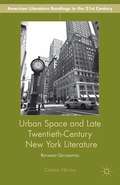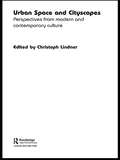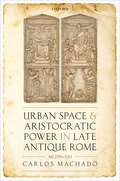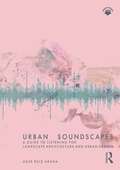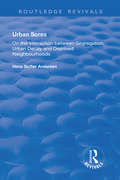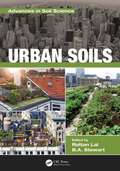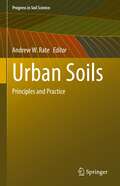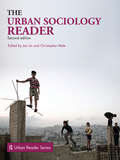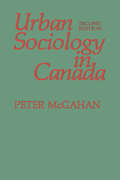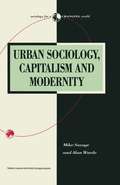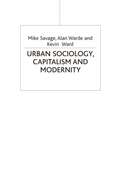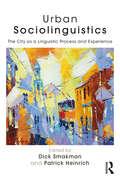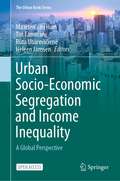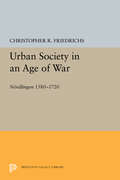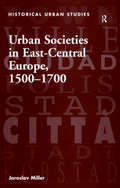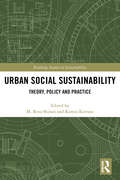- Table View
- List View
Urban Space and Late Twentieth-Century New York Literature: Reformed Geographies (American Literature Readings in the 21st Century)
by C. NeculaiInterdisciplinary in nature, this project draws on fiction, non-fiction and archival material to theorize urban space and literary/cultural production in the context of the United States and New York City. Spanning from the mid-1970s fiscal crisis to the 1987 Market Crash, New York writing becomes akin to geographical fieldwork in this rich study.
Urban Space and Cityscapes: Perspectives from Modern and Contemporary Culture
by Christoph LindnerFrom the verticals of New York, Hong Kong and Singapore to the sprawls of London, Paris and Jakarta, this interdisciplinary volume of new writing examines constructions, representations, imaginations and theorizations of 'cityscapes' in modern and contemporary culture. With specially-commissioned essays from the fields of cultural theory, architecture, film, literature, visual art and urban geography, it offers fresh insight into the increasingly complex relationship between urban space, cultural production and everyday life. This volume draws on critical urban studies and moves beyond familiar cultural representations of the city by considering urban planning and architecture. Organized under three inter-related themes - image, text and form - essay topics range from the examination of cyberpunk skylines, pagan urbanism and the cinema of urban disaster, to the analysis of iconic city landmarks such as the twin towers, the London Eye and the Judisches Museum Berlin. Covering a diverse range of cities, including Berlin, Chicago, Jakarta, Johannesburg, Hong Kong, London, Los Angeles, Paris, and Venice, this fantastic resource for students, scholars and researchers alike, works expertly at the intersections of visual, material, and literary culture.
Urban Space and Cityscapes: Perspectives from Modern and Contemporary Culture
by Christoph LindnerFrom the verticals of New York, Hong Kong and Singapore to the sprawls of London, Paris and Jakarta, this interdisciplinary volume of new writing examines constructions, representations, imaginations and theorizations of 'cityscapes' in modern and contemporary culture. With specially-commissioned essays from the fields of cultural theory, architecture, film, literature, visual art and urban geography, it offers fresh insight into the increasingly complex relationship between urban space, cultural production and everyday life. This volume draws on critical urban studies and moves beyond familiar cultural representations of the city by considering urban planning and architecture. Organized under three inter-related themes - image, text and form - essay topics range from the examination of cyberpunk skylines, pagan urbanism and the cinema of urban disaster, to the analysis of iconic city landmarks such as the twin towers, the London Eye and the Judisches Museum Berlin. Covering a diverse range of cities, including Berlin, Chicago, Jakarta, Johannesburg, Hong Kong, London, Los Angeles, Paris, and Venice, this fantastic resource for students, scholars and researchers alike, works expertly at the intersections of visual, material, and literary culture.
Urban Space and Aristocratic Power in Late Antique Rome: AD 270-535
by Carlos MachadoBetween 270 and 535 AD the city of Rome experienced dramatic changes. The once glorious imperial capital was transformed into the much humbler centre of western Christendom in a process that redefined its political importance, size, and identity. Urban Space and Aristocratic Power in Late Antique Rome examines these transformations by focusing on the city's powerful elite, the senatorial aristocracy, and exploring their involvement in a process of urban change that would mark the end of the ancient world and the birth of the Middle Ages in the eyes of contemporaries and modern scholars. It argues that the late antique history of Rome cannot be described as merely a product of decline; instead, it was a product of the dynamic social and cultural forces that made the city relevant at a time of unprecedented historical changes. Combining the city's unique literary, epigraphic, and archaeological record, the volume offers a detailed examination of aspects of city life as diverse as its administration, public building, rituals, housing, and religious life to show how the late Roman aristocracy gave a new shape and meaning to urban space, identifying itself with the largest city in the Mediterranean world to an extent unparalleled since the end of the Republican period.
Urban Space and Aristocratic Power in Late Antique Rome: AD 270-535
by Carlos MachadoBetween 270 and 535 AD the city of Rome experienced dramatic changes. The once glorious imperial capital was transformed into the much humbler centre of western Christendom in a process that redefined its political importance, size, and identity. Urban Space and Aristocratic Power in Late Antique Rome examines these transformations by focusing on the city's powerful elite, the senatorial aristocracy, and exploring their involvement in a process of urban change that would mark the end of the ancient world and the birth of the Middle Ages in the eyes of contemporaries and modern scholars. It argues that the late antique history of Rome cannot be described as merely a product of decline; instead, it was a product of the dynamic social and cultural forces that made the city relevant at a time of unprecedented historical changes. Combining the city's unique literary, epigraphic, and archaeological record, the volume offers a detailed examination of aspects of city life as diverse as its administration, public building, rituals, housing, and religious life to show how the late Roman aristocracy gave a new shape and meaning to urban space, identifying itself with the largest city in the Mediterranean world to an extent unparalleled since the end of the Republican period.
Urban Soundscapes: A Guide to Listening for Landscape Architecture and Urban Design
by Usue Ruiz AranaSound and listening are intrinsically linked to how we experience and engage with places and communities. This guide puts forward a new conceptual framework of embodied affectivity that emphasises listening in urban research and design and advances new ways of knowing and making. The guide invites landscape architects and urban designers to become soundscape architects and offers practical advice on sound and listening applicable to each stage of a design project: from reading the environment to intervening on it.Urban Soundscapes foregrounds listening as an affective mediator between subjects and multispecies environments, and a vehicle to think and conceptualise environmental research and design beyond prevailing visual and human-centred modes. The guide expands landscape architects’ and urban designers’ tools and skills to assess existing soundscapes, predict how those soundscapes will be altered through their designs, consider sound as a creative and active part of the design process and envisage how users might perceive and be affected by those soundscapes as they evolve in time. The volume sits in the interface of research and practice and interweaves theoretical, methodological and creative contributions from acoustic ecology, ecoacoustics, bioacoustics and sound art. Each of the design stages is illustrated through project examples that demonstrate the many advantages of incorporating attentive listening and sound into Landscape Architecture and Urban Design Practice. This book shows how incorporating listening and sounding as part of the design process promotes slow and subtle ways of practice, adds social and ecological value through the reduction of noise pollution and by monitoring the health of habitats, and enables the design of soundscapes that complement the character and design intent of a scheme and elicit joy and wonder.The book will be of interest to practitioners and academics in landscape architecture, and other design and spatial fields such as urban design, architecture, geography and engineering, who play a primary role in the composition of the soundscape.
Urban Soundscapes: A Guide to Listening for Landscape Architecture and Urban Design
by Usue Ruiz AranaSound and listening are intrinsically linked to how we experience and engage with places and communities. This guide puts forward a new conceptual framework of embodied affectivity that emphasises listening in urban research and design and advances new ways of knowing and making. The guide invites landscape architects and urban designers to become soundscape architects and offers practical advice on sound and listening applicable to each stage of a design project: from reading the environment to intervening on it.Urban Soundscapes foregrounds listening as an affective mediator between subjects and multispecies environments, and a vehicle to think and conceptualise environmental research and design beyond prevailing visual and human-centred modes. The guide expands landscape architects’ and urban designers’ tools and skills to assess existing soundscapes, predict how those soundscapes will be altered through their designs, consider sound as a creative and active part of the design process and envisage how users might perceive and be affected by those soundscapes as they evolve in time. The volume sits in the interface of research and practice and interweaves theoretical, methodological and creative contributions from acoustic ecology, ecoacoustics, bioacoustics and sound art. Each of the design stages is illustrated through project examples that demonstrate the many advantages of incorporating attentive listening and sound into Landscape Architecture and Urban Design Practice. This book shows how incorporating listening and sounding as part of the design process promotes slow and subtle ways of practice, adds social and ecological value through the reduction of noise pollution and by monitoring the health of habitats, and enables the design of soundscapes that complement the character and design intent of a scheme and elicit joy and wonder.The book will be of interest to practitioners and academics in landscape architecture, and other design and spatial fields such as urban design, architecture, geography and engineering, who play a primary role in the composition of the soundscape.
Urban Sores: On the Interaction between Segregation, Urban Decay and Deprived Neighbourhoods
by Hans Skifter AndersenThis title was first published in 2003. Most European cities have experienced problems in certain neighbourhoods that are termed deprived or excluded . Traditionally these were found in the oldest urban areas with lowest quality housing, but since the 1980s, such areas have emerged in housing estates built around the cities' edges. These neighbourhoods are marked by visible physical and social problems that disfigure the otherwise pleasant urban landscape, and can be seen as urban sores . This engaging and thought-provoking book provides a deeper understanding of why urban decay and deprived neighbourhoods appear in certain parts of cities, as well as how they affect residents and cities in general. Drawing on in-depth empirical research from Denmark, it compares this with other studies from Europe and the United States. The author combines theories and methodologies from the fields of geography (on segregation), economics (on processes of urban decay) and social research (on social exclusion and deprived neighbourhoods) to provide original, illuminating and invaluable insights.
Urban Sores: On the Interaction between Segregation, Urban Decay and Deprived Neighbourhoods
by Hans Skifter AndersenThis title was first published in 2003. Most European cities have experienced problems in certain neighbourhoods that are termed deprived or excluded . Traditionally these were found in the oldest urban areas with lowest quality housing, but since the 1980s, such areas have emerged in housing estates built around the cities' edges. These neighbourhoods are marked by visible physical and social problems that disfigure the otherwise pleasant urban landscape, and can be seen as urban sores . This engaging and thought-provoking book provides a deeper understanding of why urban decay and deprived neighbourhoods appear in certain parts of cities, as well as how they affect residents and cities in general. Drawing on in-depth empirical research from Denmark, it compares this with other studies from Europe and the United States. The author combines theories and methodologies from the fields of geography (on segregation), economics (on processes of urban decay) and social research (on social exclusion and deprived neighbourhoods) to provide original, illuminating and invaluable insights.
Urban Soils (Advances in Soil Science)
by Rattan Lal B. A. StewartGlobally, 30% of the world population lived in urban areas in 1950, 54% in 2016 and 66% projected by 2050. The most urbanized regions include North America, Latin America, and Europe. Urban encroachment depletes soil carbon and the aboveground biomass carbon pools, enhancing the flux of carbon from soil and vegetation into the atmosphere. Thus, urbanization has exacerbated ecological and environmental problems. Urban soils are composed of geological material that has been drastically disturbed by anthropogenic activities and compromised their role in the production of food, aesthetics of residential areas, and pollutant dynamics. Properties of urban soils are normally not favorable to plant growth—the soils are contaminated by heavy metals and are compacted and sealed. Therefore, the quality of urban soils must be restored to make use of this valuable resource for delivery of essential ecosystem services (e.g., food, water and air quality, carbon sequestration, temperature moderation, biodiversity). Part of the Advances in Soil Sciences Series, Urban Soils explains properties of urban soils; assesses the effects of urbanization on the cycling of carbon, nitrogen, and water and the impacts of management of urban soils, soil restoration, urban agriculture, and food security; evaluates ecosystem services provisioned by urban soils, and describes synthetic and artificial soils.
Urban Soils (Advances in Soil Science)
by Rattan Lal B. A. StewartGlobally, 30% of the world population lived in urban areas in 1950, 54% in 2016 and 66% projected by 2050. The most urbanized regions include North America, Latin America, and Europe. Urban encroachment depletes soil carbon and the aboveground biomass carbon pools, enhancing the flux of carbon from soil and vegetation into the atmosphere. Thus, urbanization has exacerbated ecological and environmental problems. Urban soils are composed of geological material that has been drastically disturbed by anthropogenic activities and compromised their role in the production of food, aesthetics of residential areas, and pollutant dynamics. Properties of urban soils are normally not favorable to plant growth—the soils are contaminated by heavy metals and are compacted and sealed. Therefore, the quality of urban soils must be restored to make use of this valuable resource for delivery of essential ecosystem services (e.g., food, water and air quality, carbon sequestration, temperature moderation, biodiversity). Part of the Advances in Soil Sciences Series, Urban Soils explains properties of urban soils; assesses the effects of urbanization on the cycling of carbon, nitrogen, and water and the impacts of management of urban soils, soil restoration, urban agriculture, and food security; evaluates ecosystem services provisioned by urban soils, and describes synthetic and artificial soils.
Urban Soils: Principles and Practice (Progress in Soil Science)
by Andrew W. RateThis textbook addresses the increasing trend in urbanization of the world’s population and its relation with urban soils. Written by active practitioners of university level teaching and research, this book is designed primarily as an educational text, while it also provides readers with an authoritative gateway to the primary literature. It includes explicit coverage of spatial and statistical (multivariate) techniques and case studies to illustrate key concept, and to support practical guidance in issues such as data collection and analysis. The authors reflect current developments in research and urban trends. In China, for example, the proportion of the population living in cities increased from 13% in 1950 to 45% in 2010 (World Bank data). Australia is one of the world's top ten urbanised countries with population greater than ten million, with approximately 90% of its population living in cities, mainly along Australia's coast. The most rapidly urbanising populations are currently in nations of the African continent. Soils in urban areas have multiple functions which are becoming more valued by urban communities: soils supply water, nutrients and physical support for urban plant and animal communities (parks, reserves, gardens), and are becoming increasingly valued for growing food. Soils may be used for building foundations, or as building materials themselves. Urban hydrology relies on the existence of unsealed soils for aquifer protection and flood control. This volume presents the importance of urban ecosystems and the impacts of global change. It examines pedogenesis of urban soils: natural materials affected by urban phenomena, and natural processes acting on urban materials, including an examination of different climatic zones. There is a focus on soils formed on landfill, reclaimed land, dredge spoils as well as soil-related changes in urban geomorphology. There is plenty of discussion on urban soil as a source and sink as well as soil geochemistry and health. The book is intended primarily as a text for upper-level undergraduate, and postgraduate (Masters) students. It will also be invaluable as a resource for professionals such as researchers, environmental regulators, and environmental consultants.
The Urban Sociology Reader (Routledge Urban Reader Series)
by Jan Lin Christopher MeleThe urban world is an exciting terrain for investigating the central institutions, structures and problems of the social world and how they have transformed through the last 200 years. This Reader comprises sections on urban social theory, racial and social difference in the city, culture in everyday life, culture and the urban economy, globalization and transnational social relations and the regulation of urban space. Drawing together seminal selections covering the nineteenth to the twenty-first centuries, this Reader includes forty-three significant writings from eminent names such as Simmel, Wirth, Park, Burgess, DuBois, Zukin, Sassen, and Harvey. The 2nd edition illuminates more recent urban issues such as sprawl, sustainability, immigration and urban protest. Selections are predominantly sociological, but some readings cross disciplinary boundaries. Providing an essential resource for students of urban studies, this book brings together important but, till now, widely dispersed writings. Editorial commentaries precede each entry; introducing the text, demonstrating its significance, and outlining the issues surrounding its topic, whilst the associated bibliography enables deeper investigations.
The Urban Sociology Reader (Routledge Urban Reader Series)
by Jan Lin Christopher MeleThe urban world is an exciting terrain for investigating the central institutions, structures and problems of the social world and how they have transformed through the last 200 years. This Reader comprises sections on urban social theory, racial and social difference in the city, culture in everyday life, culture and the urban economy, globalization and transnational social relations and the regulation of urban space. Drawing together seminal selections covering the nineteenth to the twenty-first centuries, this Reader includes forty-three significant writings from eminent names such as Simmel, Wirth, Park, Burgess, DuBois, Zukin, Sassen, and Harvey. The 2nd edition illuminates more recent urban issues such as sprawl, sustainability, immigration and urban protest. Selections are predominantly sociological, but some readings cross disciplinary boundaries. Providing an essential resource for students of urban studies, this book brings together important but, till now, widely dispersed writings. Editorial commentaries precede each entry; introducing the text, demonstrating its significance, and outlining the issues surrounding its topic, whilst the associated bibliography enables deeper investigations.
Urban Sociology in Canada
by Peter McGahanUrban Sociology in Canada, Second Edition introduces the fundamentals of the theoretical structure of Canadian urban studies. The book is comprised of 11 chapters that are organized into six parts. The text provides census data of various Canadian cities along with urban empirical studies to help illustrate the generalization and concepts. The book first covers the classical foundations of urban sociology, and then proceeds to discussing the growth of urban system. The third part talks about the process of entrance to the urban system, while the fourth part deals with the spatial shape of the urban system. The last two parts tackle urbanism and the regulation of urban system, respectively. The book will be of great use to social scientists who involve urban population as the main demographics of their research study.
Urban Sociology, Capitalism and Modernity (Sociology for a Changing World)
by Michael Savage Alan WardeThis text seeks to defend the achievements of urban sociology and its contribution to evaluating theories of the nature and implications of both capitalism and modernity. The book reviews the history of urban sociology, theories of uneven development, studies of urban inequalities, analyses of urban culture and meaning and urban politics. It argues that urban sociology can be conceived as an extended empirical inquiry into the nature of capitalist modernity.
Urban Sociology, Capitalism and Modernity (Sociology for a Changing World)
by Kevin Ward Mike Savage A. WardeThe long-awaited second edition of this highly successful text on urban sociology retains the distinctive character and focus of the original, while taking fully into account recent theoretical debates and new empirical research. Expanded and thoroughly revised throughout, it incorporates the substantial new literature on urban inequality, urban culture, urban politics and globalization. It thus offers a comprehensive and up-to-the-minute account of its subject, ideal for study purposes at undergraduate level and beyond.
Urban Sociolinguistics: The City as a Linguistic Process and Experience
by Dick Smakman Patrick HeinrichFrom Los Angeles to Tokyo, Urban Sociolinguistics is a sociolinguistic study of twelve urban settings around the world. Building on William Labov’s famous New York Study, the authors demonstrate how language use in these areas is changing based on belief systems, behavioural norms, day-to-day rituals and linguistic practices. All chapters are written by key figures in sociolinguistics and presents the personal stories of individuals using linguistic means to go about their daily communications, in diverse sociolinguistic systems such as: extremely large urban conurbations like Cairo, Tokyo, and Mexico City smaller settings like Paris and Sydney less urbanised places such as the Western Netherlands Randstad area and Kohima in India. Providing new perspectives on crucial themes such as language choice and language contact, code-switching and mixing, language and identity, language policy and planning and social networks, this is key reading for students and researchers in the areas of multilingualism and super-diversity within sociolinguistics, applied linguistics and urban studies.
Urban Sociolinguistics: The City as a Linguistic Process and Experience
by Dick Smakman Patrick HeinrichFrom Los Angeles to Tokyo, Urban Sociolinguistics is a sociolinguistic study of twelve urban settings around the world. Building on William Labov’s famous New York Study, the authors demonstrate how language use in these areas is changing based on belief systems, behavioural norms, day-to-day rituals and linguistic practices. All chapters are written by key figures in sociolinguistics and presents the personal stories of individuals using linguistic means to go about their daily communications, in diverse sociolinguistic systems such as: extremely large urban conurbations like Cairo, Tokyo, and Mexico City smaller settings like Paris and Sydney less urbanised places such as the Western Netherlands Randstad area and Kohima in India. Providing new perspectives on crucial themes such as language choice and language contact, code-switching and mixing, language and identity, language policy and planning and social networks, this is key reading for students and researchers in the areas of multilingualism and super-diversity within sociolinguistics, applied linguistics and urban studies.
Urban Socio-Economic Segregation and Income Inequality: A Global Perspective (The Urban Book Series)
by Maarten Van Ham Tiit Tammaru Rūta Ubarevičienė Heleen JanssenThis open access book investigates the link between income inequality and socio-economic residential segregation in 24 large urban regions in Africa, Asia, Australia, Europe, North America, and South America. It offers a unique global overview of segregation trends based on case studies by local author teams. The book shows important global trends in segregation, and proposes a Global Segregation Thesis.Rising inequalities lead to rising levels of socio-economic segregation almost everywhere in the world. Levels of inequality and segregation are higher in cities in lower income countries, but the growth in inequality and segregation is faster in cities in high-income countries. This is causing convergence of segregation trends. Professionalisation of the workforce is leading to changing residential patterns. High-income workers are moving to city centres or to attractive coastal areas and gated communities, while poverty is increasingly suburbanising. As a result, the urban geography of inequality changes faster and is more pronounced than changes in segregation levels. Rising levels of inequality and segregation pose huge challenges for the future social sustainability of cities, as cities are no longer places of opportunities for all.
Urban Society in an Age of War: Nördlingen 1580-1720
by Christopher R. FriedrichsUnder the premise that local history can illuminate aspects of the past in ways that few works of broad historical synthesis can ever hope to equal, Christopher Friedrichs draws a comprehensive portrait of the small German city of Nördlingen during a turbulent century and a half of early modern history. In doing so he explores the transition from a traditional to a modern way of life.Originally published in 1980.The Princeton Legacy Library uses the latest print-on-demand technology to again make available previously out-of-print books from the distinguished backlist of Princeton University Press. These editions preserve the original texts of these important books while presenting them in durable paperback and hardcover editions. The goal of the Princeton Legacy Library is to vastly increase access to the rich scholarly heritage found in the thousands of books published by Princeton University Press since its founding in 1905.
Urban Societies in East-Central Europe, 1500–1700
by Jaroslav MillerWhilst much has been written about early modern urban history, the majority of this work has focussed on Western Europe with relatively little available in English on towns and cities in the former communist East. However, in recent years urban scholars have increasingly looked to a much more inclusive picture of Europe that compares and contrasts development across the whole continent. Dealing primarily with Bohemia, Hungary and the Polish-Lithuanian Commonwealth, this book provides an insight into a number of key issues concerning the economic, social and demographic trends in early modern East-Central European urban history. Taking a supra-national perspective, across a long time span, it examines the effects of migration, Reformation, state building and economic change on the transformation of medieval urban communities into early modern societies. Drawing on a wealth of primary sources, particularly the registers of new citizens kept by many towns and cities, a fascinating picture of urban development and social structure is reconstructed that not only tells us much about East-Central Europe, but adds to our knowledge of the whole continent.
Urban Societies in East-Central Europe, 1500–1700
by Jaroslav MillerWhilst much has been written about early modern urban history, the majority of this work has focussed on Western Europe with relatively little available in English on towns and cities in the former communist East. However, in recent years urban scholars have increasingly looked to a much more inclusive picture of Europe that compares and contrasts development across the whole continent. Dealing primarily with Bohemia, Hungary and the Polish-Lithuanian Commonwealth, this book provides an insight into a number of key issues concerning the economic, social and demographic trends in early modern East-Central European urban history. Taking a supra-national perspective, across a long time span, it examines the effects of migration, Reformation, state building and economic change on the transformation of medieval urban communities into early modern societies. Drawing on a wealth of primary sources, particularly the registers of new citizens kept by many towns and cities, a fascinating picture of urban development and social structure is reconstructed that not only tells us much about East-Central Europe, but adds to our knowledge of the whole continent.
Urban Social Sustainability: Theory, Policy and Practice (Routledge Studies in Sustainability)
by Ramin Keivani M. Reza ShiraziThis ground breaking volume raises radical critiques and proposes innovative solutions for social sustainability in the built environment. Urban Social Sustainability provides an in-depth insight into the discourse and argues that every urban intervention has a social sustainability dimension that needs to be taken into consideration, and incorporated into a comprehensive and cohesive ‘urban agenda’ that is built on three principles of recognition, integration, and monitoring. This should be achieved through a dialogical and reflexive process of decision-making. To achieve sustainable communities, social sustainability should form the basis of a constructive dialogue and be interlinked with other areas of sustainable development. This book underlines the urgency of approaching social sustainability as an urban agenda and goes on to make suggestions about its formulation. Urban Social Sustainability consists of original contributions from academics and experts within the field and explores the significance of social sustainability from different perspectives. Areas covered include urban policy, transportation and mobility, urban space and architectural form, housing, urban heritage, neighbourhood development, and urban governance. Drawing on case studies from a number of countries and world regions the book presents a multifaceted and interdisciplinary understanding from social sustainability in urban settings, and provides practitioners and policy makers with innovative recommendations to achieve more socially sustainable urban environment.
Urban Social Sustainability: Theory, Policy and Practice (Routledge Studies in Sustainability)
by M. Reza Shirazi Ramin KeivaniThis ground breaking volume raises radical critiques and proposes innovative solutions for social sustainability in the built environment. Urban Social Sustainability provides an in-depth insight into the discourse and argues that every urban intervention has a social sustainability dimension that needs to be taken into consideration, and incorporated into a comprehensive and cohesive ‘urban agenda’ that is built on three principles of recognition, integration, and monitoring. This should be achieved through a dialogical and reflexive process of decision-making. To achieve sustainable communities, social sustainability should form the basis of a constructive dialogue and be interlinked with other areas of sustainable development. This book underlines the urgency of approaching social sustainability as an urban agenda and goes on to make suggestions about its formulation. Urban Social Sustainability consists of original contributions from academics and experts within the field and explores the significance of social sustainability from different perspectives. Areas covered include urban policy, transportation and mobility, urban space and architectural form, housing, urban heritage, neighbourhood development, and urban governance. Drawing on case studies from a number of countries and world regions the book presents a multifaceted and interdisciplinary understanding from social sustainability in urban settings, and provides practitioners and policy makers with innovative recommendations to achieve more socially sustainable urban environment.
